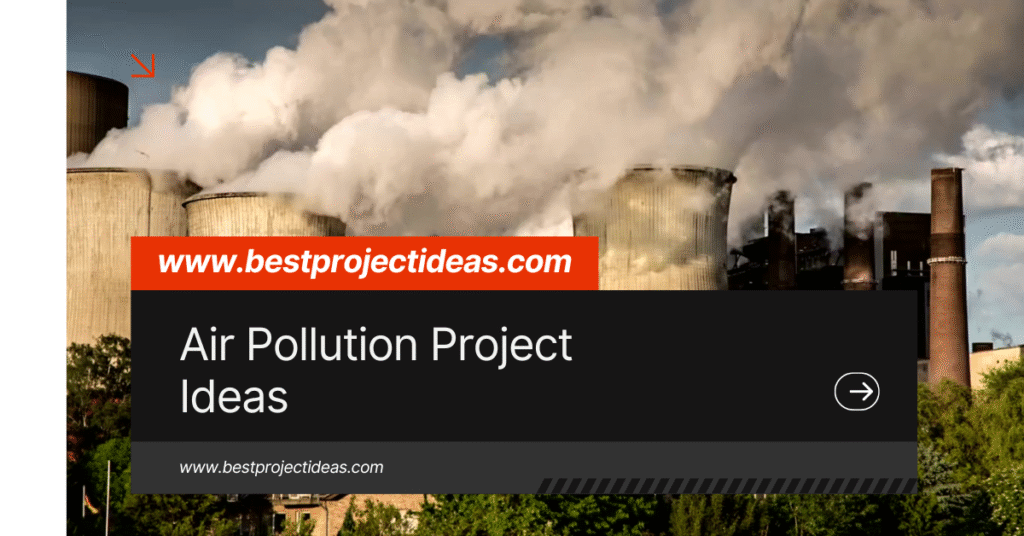
Air pollution is a growing concern that affects health, climate, and ecosystems across the globe. As students, educators, and changemakers, tackling this issue through innovative projects is more important than ever.
This blog is your complete guide to understanding air pollution and turning that knowledge into action.
From tech-based sensors to educational campaigns, you’ll find over 89 hands-on air pollution project ideas that inspire awareness, encourage creativity, and build real-world skills.
Whether you’re preparing for a science fair or working on a college assignment, these projects will empower you to make a difference—one breath at a time.
What Is Air Pollution?
Air pollution refers to the presence of substances in the atmosphere that are harmful to humans, animals, plants, or materials. These substances can be:
- Particulate Matter (PM): Tiny solid or liquid particles (PM₂.₅ and PM₁₀) from dust, soot, or smoke.
- Gases: Such as carbon monoxide (CO), nitrogen oxides (NOₓ), sulfur dioxide (SO₂), and ozone (O₃).
- Biological Pollutants: Pollen, mold spores, bacteria, and viruses.
- Volatile Organic Compounds (VOCs): Emitted from paints, cleaners, and industrial solvents.
Air pollution sources are broadly divided into:
- Natural: Wildfires, volcanic eruptions, dust storms.
- Anthropogenic (Human-made): Vehicle emissions, industrial discharge, burning fossil fuels.
Understanding these basics sets the stage for designing meaningful projects that measure, analyze, or mitigate pollution.
Discover More: Top 367+ Pollution Project Ideas: Simple, Impactful Science Projects for Students
How Do I Choose a Project Topic?
Selecting the right project topic is crucial. Follow these steps:
- Identify Your Interests:
Think about whether you’re drawn to data analysis, engineering, community outreach, or creative design. - Assess Resources:
Consider the equipment, time, budget, and expertise you have. Do you have access to sensors, lab space, or software tools? - Define Your Goals:
Are you aiming to measure, model, reduce, or educate about air pollution? A clear goal guides your methodology. - Research Existing Work:
Review scientific papers, online tutorials, or local initiatives to avoid reinventing the wheel and to find gaps you can fill. - Narrow Your Scope:
Too broad a topic can be overwhelming. Instead of “city-wide air quality,” focus on “air quality around school playgrounds” or “emissions from two-stroke engines.”
By following these steps, you’ll land on a project that’s both manageable and impactful.
Informative 89+ Air Pollution Project Ideas 2025-26
Monitoring and Measurement Projects
- DIY Air Quality Monitor
Build a low-cost device using sensors (like Arduino and MQ-series) to measure PM2.5, PM10, CO₂, and VOCs. Document readings over time and compare with local weather data. - Mobile Pollution Tracker App
Create a smartphone app that uses built-in sensors (or external Bluetooth sensors) to log air quality data while moving. Visualize pollution hotspots on a map. - Indoor vs. Outdoor Comparison
Set up identical sensors indoors and outdoors. Collect data for a month to analyze differences in pollutant levels and identify indoor pollution sources. - Seasonal Air Quality Study
Record pollutant concentrations over different seasons. Analyze how temperature, humidity, and wind patterns affect local air quality. - Vegetation Barrier Effectiveness
Measure pollutant levels on both sides of a tree line or hedge. Evaluate how green barriers filter particulates and improve air quality. - Traffic-Related Pollution Mapping
Position sensors at various distances from a busy road. Quantify how pollutant concentrations decrease with distance from traffic. - DIY UV–Visible Spectrophotometer
Build a simple spectrophotometer to estimate NO₂ levels in the air by analyzing light absorption, then calibrate using known standards. - Low-Cost Sensor Calibration Study
Compare readings from commercial low-cost sensors with reference-grade equipment. Develop calibration curves to improve accuracy. - Black Carbon Measurement
Design a basic filter-based method to collect black carbon particulates. Quantify mass using image analysis or gravimetric methods. - Gas Chromatography for VOCs
Assemble a small GC setup (or use a lab’s) to identify and quantify volatile organic compounds from household products. - Citizen Science Network
Organize community volunteers to deploy identical sensors around town. Aggregate data to create a detailed pollution map. - DIY PM Sensor Housing Design
Engineer a low-turbulence enclosure for particulate sensors. Test different designs to minimize measurement error. - Airborne Pollen and Spore Counting
Use sticky slides and microscopy to count pollen grains and spores. Relate counts to allergy reports and weather conditions. - Acoustic Pollution Sensing
Combine sound level meters with air quality sensors to study how noise pollution correlates with chemical pollutants in urban areas. - Remote Sensing Validation
Compare ground-based sensor data with satellite-derived air quality indices. Analyze discrepancies and improve local estimation models.
Awareness and Education Projects
- School Workshop on Air Pollution
Develop interactive activities (e.g., filter demonstrations, pollutant-collecting balloons) to teach students about common air pollutants. - Interactive Pollution Quiz Website
Build a web-based quiz game that educates users about pollutant sources, health impacts, and mitigation strategies. - Public Art Installation
Create a display that visually represents daily air quality (e.g., colored ribbons or lights changing with AQI levels). - Educational Podcast Series
Produce short episodes interviewing experts and affected community members, explaining air pollution in simple language. - Animated Infographic Videos
Design animated clips showing how pollutants form and travel. Share on social media to raise awareness. - Neighborhood Air Quality Newsletter
Compile weekly summaries of local air quality data with tips for residents on reducing exposure and emissions. - Virtual Reality Pollution Experience
Develop a VR simulation that immerses users in highly polluted vs. clean-air environments to highlight differences. - Air Pollution Board Game
Design a board game where players manage city pollution by balancing industrial growth, transport, and green spaces. - Community Science Fair Exhibit
Present simple experiments (e.g., candle smoke filtering) and data displays at a local fair to engage attendees. - School Science Club Projects
Guide students to build small sensors and report findings. Encourage inter-school competitions on pollution monitoring. - Air Quality Awareness Campaign
Create posters, flyers, and social media posts explaining AQI categories and health advice for sensitive groups. - Interactive Kiosk at Public Spaces
Install touchscreens showing live AQI data, pollutant sources, and tips for travelers, commuters, and shoppers. - Art Contest: “Clean Air” Theme
Invite students to submit paintings or photographs reflecting clean-air aspirations. Display winners in community centers. - Citizen Science Air Walks
Lead guided walks with portable sensors, narrating pollution sources along the route and mitigation strategies. - DIY Mask Demonstrations
Show participants how basic homemade masks filter particulates. Compare different fabrics and layering techniques.
Technological Solutions for Pollution Reduction
- Electrostatic Precipitator Prototype
Build a small-scale electrostatic filter to remove particulates from a passing air stream. Test efficiency at different voltages. - Photocatalytic Oxidation Chamber
Create a chamber coated with TiO₂ that uses UV light to break down VOCs and NOₓ. Measure inflow and outflow concentrations. - Smart Window Ventilation System
Design a system that opens or closes windows based on indoor/outdoor AQI, temperature, and humidity readings. - Air-Purifying Paint Development
Experiment with additives (e.g., photocatalysts) in paint to degrade pollutants on painted surfaces. Test pollutant breakdown rates. - Green Roof Filter Study
Install a mini green roof on a model building. Measure how vegetation and substrate reduce PM and VOCs indoors. - Portable Solar-Powered Air Purifier
Combine solar panels with fan and filters to create a self-powered device that cleans air in remote areas. - Biofilter Using Local Plants
Construct a living wall of potted plants known to absorb pollutants (e.g., spider plant, peace lily). Test air quality changes. - Ultrasonic Humidifier Filter
Modify a humidifier with specialized filter media (e.g., activated carbon) to remove pollutants while humidifying air. - Wearable Air Quality Alert
Design a small badge or bracelet that vibrates or lights up when pollutant levels exceed thresholds. - Drone-Based Sampling System
Mount lightweight sensors on a drone to map pollutant concentrations at different altitudes and locations. - Airflow Optimization in Buildings
Use CFD (computational fluid dynamics) simulations to optimize HVAC designs for better pollutant removal. - Smart Traffic Light Coordination
Develop algorithms that adjust traffic signals to reduce idling times and emissions at busy intersections. - Mobile Filter Installation
Retrofit a bus or van with industrial-grade filters to act as a “clean air” mobile unit serving pollution hotspots. - Electrochemical Sensor Array
Assemble multiple electrochemical cells to detect different gases simultaneously. Integrate with microcontroller for data logging. - Nanofiber Filter Fabrication
Produce nanofiber mats via electrospinning. Test particulate capture efficiency compared to commercial filters. - AI-Controlled Purifier
Create a purifier that uses machine learning to predict pollution spikes and adjust fan speed and filtering accordingly. - Recycled Material Filters
Test the effectiveness of filters made from recycled textiles or plastic bottles in trapping particulates. - Solar Chimney for Ventilation
Build a model solar chimney that uses solar heat to drive airflow, improving ventilation and pollutant removal. - Catalytic Converter Simulation
Model how automotive catalytic converters reduce NOₓ and CO emissions. Validate results with small-scale tests. - Hydroponic Air Scrubber
Design a hydroponic system where plants both photosynthesize and filter air. Measure combined pollutant removal.
Health Impact and Mitigation Studies
- Respiratory Health Survey
Conduct questionnaires in a community to correlate self-reported symptoms with local AQI data. - Allergy Trigger Analysis
Track pollen counts and particulate levels, then monitor allergy medication sales to find correlations. - Indoor Air Quality Improvement Tips
Test how simple actions (opening windows, using fans, air purifiers) reduce indoor pollutant concentrations. - Mask Efficacy Testing
Compare N95, surgical, and cloth masks using a particle counter to measure filtration of fine particulates. - School Children Exposure Study
Measure pollutant levels in classrooms and playgrounds. Relate exposure times to potential health risks. - Exercise Pollution Interaction
Monitor heart rate and lung function of volunteers exercising in low vs. high pollution areas to assess risks. - Asthma Attack Forecast Model
Develop a simple model using AQI and weather data to predict high-risk asthma days. Validate with hospital admission data. - Plant-Based Air Filtration in Homes
Place common houseplants in bedrooms. Measure overnight pollutant levels and assess improvements in sleep quality. - Smog Chamber Simulation
Create a small controlled chamber to simulate smog formation under UV light. Analyze secondary pollutant formation. - Cough and Sneeze Particle Spread
Use high-speed cameras and laser sheets to visualize droplets and aerosols in polluted vs. clean air. - Psychological Effects of Pollution
Use surveys and simple cognitive tests to see if high pollution days affect mood, concentration, or stress. - DIY Personal Exposure Monitor
Build a wearable badge that logs pollution exposure over a day. Compare exposure profiles of cyclists vs. drivers. - Correlating Pollution with School Attendance
Analyze attendance records during high-pollution episodes to quantify absenteeism impact. - Air Pollutants in Food Chains
Measure deposition of particulates on leafy vegetables grown in urban vs. rural gardens to assess food contamination. - Respirator Fit and Comfort Study
Test different respirator designs for fit, breathing resistance, and comfort during prolonged use.
Policy, Management, and Community Engagement
- Local Emission Inventory
Survey local industries, transport, and households. Estimate their contributions to overall emissions and suggest improvements. - School Idling Reduction Campaign
Work with a school to implement “no-idling” zones for parent pick-up and drop-off. Measure local pollutant changes. - Policy Impact Analysis
Study the effect of recent local regulations (e.g., diesel bans) on air quality trends using historical data. - Green Zone Planning
Propose locations for new parks or green corridors in a city. Simulate how these would lower pollutant levels. - Community Monitoring Network
Train residents to use portable sensors. Aggregate data in a public dashboard to inform policymakers. - Car-Free Day Proposal
Design and promote a “car-free Sunday” event. Measure air quality before, during, and after the event. - Incentive Program for Clean Stoves
Survey households using solid-fuel stoves. Develop subsidy models for cleaner alternatives and estimate emission reductions. - Urban Tree-Planting Strategy
Identify optimal species and planting locations. Model long-term benefits for air purification. - Waste Burning Awareness Project
Document the practice of open waste burning. Create educational materials to discourage it and propose alternatives. - Smart City Integration Plan
Outline how IoT air sensors can tie into city management systems for real-time pollution control measures. - Industry Best Practices Handbook
Compile guidelines for local factories to minimize emissions. Include process changes and cost-benefit analyses. - Public Transport Improvement Proposal
Analyze current routes and ridership. Suggest additions or optimizations to reduce private vehicle use. - Emission Trading Simulation Game
Create a role-playing game where players trade emission credits and learn about cap-and-trade systems. - Air Quality Alert System
Design an SMS or app-based alert for residents when AQI exceeds safe levels, offering health advice. - Stakeholder Interview Series
Record interviews with government officials, NGOs, and residents to capture diverse views on air pollution solutions.
Data Analysis, Modeling, and Predictive Projects
- AQI Time-Series Forecasting
Use machine learning (e.g., ARIMA or LSTM) to predict future AQI values based on historical data and weather variables. - Spatial Interpolation of Sensor Data
Apply kriging or IDW methods to estimate pollutant levels at unsampled locations. Validate with spot measurements. - Source Apportionment Study
Analyze chemical composition of particulates to determine contributions from traffic, industry, and biomass burning. - Correlation of AQI with Health Records
Use statistical tests to link hospital admissions (e.g., for asthma) with AQI fluctuations over time. - Pollution Hotspot Identification
Cluster analysis on hourly AQI data to identify times and places with consistently high pollution. - Mobile Data Fusion
Combine GPS movement tracks with sensor readings to map personal exposure landscapes for individuals. - Impact of Meteorology on Pollution Dispersion
Model how wind speed, direction, and temperature inversions affect pollutant spread using simple Gaussian models. - Web Dashboard for Real-Time Analytics
Build an interactive dashboard (e.g., using Python Flask or JavaScript) to visualize live and historical air quality data. - Deep Learning Image Analysis
Train a CNN to estimate haze levels from webcam or satellite images. Compare predictions with sensor data. - Cost–Benefit Analysis Tool
Develop a spreadsheet-based model that calculates economic benefits of pollution reduction measures versus implementation costs.
Why Air Pollution Projects Matter
- Public Health:
Research shows that long-term exposure to polluted air increases risks of respiratory diseases, heart conditions, and stroke. - Environmental Protection:
Airborne pollutants contribute to acid rain, ozone depletion, and global warming—projects can help monitor and curb these effects. - Community Awareness:
Hands-on projects often involve local stakeholders, raising awareness and driving community-led solutions. - Skill Development:
From data analysis and programming to reporting and presentation, you’ll build a versatile skill set valuable across STEM and social sciences. - Policy Influence:
Well-documented projects can inform policymakers and support regulations that improve air quality standards.
Discover More: 237+ Trending Environmental Capstone Project Ideas For Students
Popular Air Pollution Projects and Related Skills
| Project Idea | Key Skills Developed |
|---|---|
| Build a DIY Air Quality Monitor with Arduino/Raspberry Pi | Electronics, programming (Python/C++), data logging |
| Analyze Local AQI Data and Predict Trends | Data science, statistics, machine learning |
| Model Dispersion of Pollutants Using Simulation Software | Computational modeling, physics, MATLAB or Python |
| Design a Green Roof Prototype to Reduce Urban Smog | Civil engineering, materials science, CAD |
| Study the Impact of Indoor Plants on VOC Levels | Biology, experimental design, analytical chemistry |
| Create an Educational App to Track and Report Air Quality | Mobile development, UI/UX design, API integration |
| Measure Emissions from Cooking Fuels in Rural Areas | Field sampling, chemical analysis, reporting |
| Assess the Effectiveness of Face Masks Against PM₂.₅ | Laboratory testing, microscopy, statistical analysis |
| Investigate Traffic Patterns and Correlate with NOₓ Levels | GIS mapping, data analytics, Python/R |
| Launch a Community “Clean Air” Awareness Campaign | Communication, social media strategy, project management |
Final Thoughts
Air pollution is more than just a topic—it’s a challenge that demands awareness, creativity, and action. Through the wide range of project ideas shared in this guide, you now have the tools to explore, analyze, and combat this invisible threat in meaningful ways.
Whether you choose to build a DIY monitor, educate your community, or develop a tech-based solution, remember that every effort counts. Let your next project be the step toward a cleaner, healthier, and more informed world.
FAQS
How can I measure air pollution at home?
You can build a low-cost monitor using sensors like the PMS5003 (for particulate matter) and the MQ series (for gases). Pair these with an Arduino or Raspberry Pi, log data to an SD card or cloud service, and visualize trends in real time.
Which plants are best for improving indoor air quality?
NASA studies highlight spider plants (Chlorophytum comosum), snake plants (Sansevieria trifasciata), and peace lilies (Spathiphyllum). These plants absorb VOCs like formaldehyde and benzene effectively.
What are the health effects of long-term exposure to PM₂.₅?
Chronic inhalation of fine particles can lead to asthma, bronchitis, cardiovascular disease, and reduced lung function. Sensitive groups include children, the elderly, and those with pre-existing conditions.
Can data from satellites be used for local air pollution projects?
Yes! Platforms like NASA’s MODIS or ESA’s Sentinel satellites provide aerosol optical depth (AOD) data. You can correlate satellite readings with ground-based sensors to get a comprehensive picture.
What low-cost solutions exist for reducing vehicle emissions?
Retrofitting vehicles with catalytic converters, promoting electric vehicle (EV) adoption, and optimizing traffic flow with smart signals can all help lower emissions significantly.

